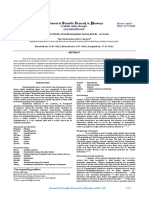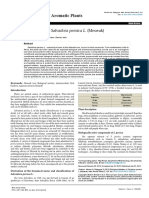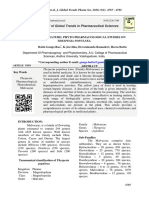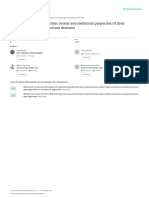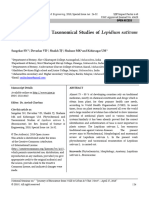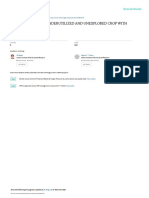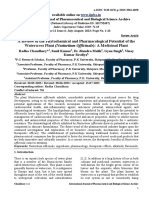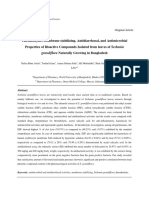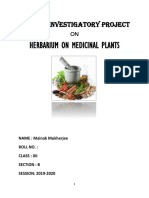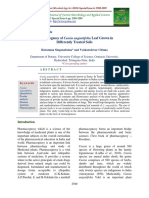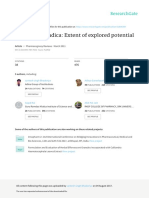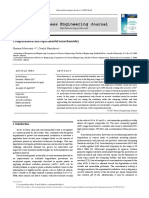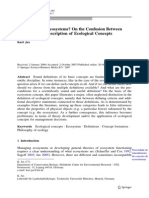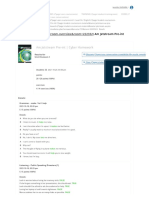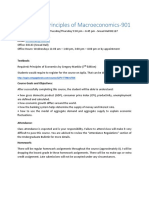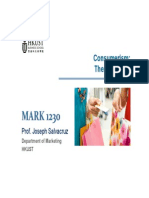Professional Documents
Culture Documents
1.lepidium New
Uploaded by
yohannesOriginal Title
Copyright
Available Formats
Share this document
Did you find this document useful?
Is this content inappropriate?
Report this DocumentCopyright:
Available Formats
1.lepidium New
Uploaded by
yohannesCopyright:
Available Formats
IAJPS 2017, 4 (08), 2223-2227 Asra Jabeen et al ISSN 2349-7750
CODEN [USA]: IAJPBB ISSN: 2349-7750
INDO AMERICAN JOURNAL OF
PHARMACEU TICAL SCIENCES
Available online at: http://www.iajps.com Review Article
A REVIEW ON LEPIDIUM SATIVUM
Asra Jabeen*1, Dr. S. Rani2, Dr. Mohammed Ibrahim3, Abdul Saleem Mohammad4,
1
Associate Professor, Department of Pharmacognosy, Nizam Institute of Pharmacy, Deshmukhi
(V), Pochampally (M), Behind Mount Opera, Yadadri Bhuvanagiri (Dist)-508284,
Telangana, India.
2
Assistant Professor, Annamalai University, Sadagopan Nagar, Annamalai Nagar, Chidambaram,
Tamil Nadu 608002, India.
3
Professor and Principal, Prathap Narender Reddy College of Pharmacy, Peddashapur,509325,
Shamshabad, Telangana, India.
4
Assistant Professor, Department of Pharmaceutical Analysis and Quality Assurance, Nizam
Institute of Pharmacy, Deshmukhi (V), Pochampally (M), Behind Mount Opera, Yadadri
Bhuvanagiri (Dist)-508284, Telangana, India.
Abstract:
Lepidium sativum plant and seeds are considered one of the popular medicinal herbs used in the community of Saudi
Arabia, Sudan and some other Arabic countries as a good mediator for bone fracture healing in the human skeleton. A
number of recent studies pointed out the traditional uses of Lepidium sativum seeds extract in controlling many clinical
problems. They were used as anti-asthmatic antiscorbutic, aperient, diuretic, galactogogue, poultice and stimulant. The
traditional plants may represent new sources of drugs with stable, biologically active components that can establish a
scientific base for the use of plants in modern medicine. These local ethnomedical preparations and prescriptions of
plant sources should be scientifically evaluated and then disseminated properly.
Key Words: Seeds, garden cress, hydroponic, phytochemicals, nutritional.
Corresponding Author:
Asra Jabeen, QR code
Associate Professor,
Department of Pharmacognosy,
Nizam Institute of Pharmacy, Deshmukhi (V), Pochampally (M),
Behind Mount Opera, Yadadri Bhuvanagiri (Dist)-508284,
Telangana, India.
Phone number: - 9700889601
E-mail address: - asra_pharma@yahoo.com
Please cite this article in press as Asra Jabeen et al, A Review on Lepidium Sativum,Indo Am. J. P. Sci, 2017; 4(8).
www.iajps.com Page 2223
IAJPS 2017, 4 (08), 2223-2227 Asra Jabeen et al ISSN 2349-7750
INTRODUCTION:[1-9] Edible shoots are typically harvested in one to two
Cress (Lepidium sativum), sometimes referred to as weeks after planting, when they are 5–13 cm (2–5 in)
garden cress to distinguish it from similar plants also tall. Garden cress is added to soups, sandwiches and
referred to as cress (from old Germanic cresso which salads for its tangy flavor. It is also eaten as sprouts,
means sharp, spicy), is a rather fast-growing, edible and the fresh or dried seed pods can be used as a
herb. Garden cress is genetically related to watercress peppery seasoning (haloon). In the United Kingdom,
and mustard, sharing their peppery, tangy flavor and cut cress shoots are commonly used in sandwiches with
aroma. In some regions, garden cress is known as boiled eggs, mayonnaise and salt.Raw cress is 89%
mustard and cress, garden pepper cress, pepperwort, water, 6% carbohydrates (including 1% dietary fiber),
pepper grass, or poor man's pepper. This annual plant 3% protein and less than 1% fat (table). In a 100 gram
can reach a height of 60 cm (~24 inches), with many amount, raw cress supplies 32 calories and numerous
branches on the upper part. The white to pinkish nutrients in significant content, including vitamin K
flowers are only 2 mm (1/12 of an inch) across, (516% of the Daily Value, DV), vitamin C (83% DV)
clustered in branched racemes. When consumed raw, and vitamin A (43% DV). Among dietary minerals,
cress is a high-nutrient food containing substantial manganese levels are high (26% DV) while several
content of vitamins A, C and K and several dietary others, including potassium and magnesium, are in
minerals. moderate contentGarden cress, known as
chandrashoor, and the seeds, known as aleev in
Marathi, or halloo in India, are commonly used in the
system of Ayurveda.
Garden cress is ideally grown hydroponically whereby
the cress is cultivated without soil using mineral
nutrient solutions in water. Garden cress is usually
harvested within two weeks of cultivation and can be
preserved by placing the stems in a water container and
then refrigerating them for at least one week
History [10-12]
It is considered to have originated from Persia and later
spread to the gardens of India, Syria, Greece and
Egypt. Garden cress is still popular and frequently
consumed type of leafy vegetables in Europe,
Fig1: Garden cress is commercially grown in especially in Scandinavia, Netherlands, England and
England, France, the Netherlands and Scandinavia. France (centers of the garden cress cultivation) where it
Cultivation of garden cress is practical both on mass is grown commercially. Due to its delightful and
scales and on the individual scale. Garden cress is peppery taste it is grown all over the world and is used
suitable for hydroponic cultivation and thrives in as healthy addition to salads and sandwiches.
slightly alkaline water. In many local markets, the Scientific classification:
demand for hydroponically grown cress can exceed Kingdom: Plantae (Plants)
available supply, partially because cress leaves are not Subkingdom: Tracheobionta (Vascular plants)
suitable for distribution in dried form, so they can only Superdivision: Spermatophyta (Seed plants)
be partially preserved. Consumers commonly acquire Division: Magnoliophyta (Flowering
cress as seeds or (in Europe) from markets as boxes of plants)
young live shoots. Class: Magnoliopsida (Dicotyledons)
Subclass: Dilleniidae
Order: Capparales
Family: Brassicaceae/Cruciferae (Mustard
family)
Genus: Lepidium L. (Pepperweed)
Species: Lepidium sativum L.
(Gardencress pepperweed)
Chemical Constituents [13-15]
The seeds shows the presence of carbohydrates,
phenolic compounds, flavonoids, alkaloids, proteins,
saponins and lipids. Thirty four percent of the total
Fig 2: Seeds of Lepidium sativum
www.iajps.com Page 2224
IAJPS 2017, 4 (08), 2223-2227 Asra Jabeen et al ISSN 2349-7750
fatty acids are alpha linolenic acid; and the oil has 10. Milk Production
alpha linoleic acid which could give it nutritional Consuming garden cress helps to stimulate the
advantages (Diwakara et al., 2008). The primary fatty mammary glands to start producing milk in lactating
acids in Lepidium sativum oil were oleic and linolenic mothers. Due to this powerful property of garden cress,
acids and was found to contain high concentrations of new mothers are encouraged to eat food containing
tocopherols. It contains good amount of lignans and garden cress to facilitate milk production. Moreover,
antioxidants, which can stabilize the n-3 due to the high protein and iron contents of garden
polyunsaturated fatty acids in its seed oil. The primary cress, it is ideally given post-partum to breastfeeding
phytosterols in Lepidium sativum were sitosterol and mothers.
campesterol, with avenasterol. The plant is known to 11. Aphrodisiac
contain imidazole, lepidine, semilepidinoside A and Consumption of garden cress greatly helps to improve
B, β-carotenes, ascorbic acid, linoleic acid, oleic acid, and boost libido.
palmitic acid, stearic acid, sinapic acid and sinapin. 12. Gastrointestinal Treatment
Benefits of Garden Cress [16-21] Garden cress can be used as a laxative and purgative
1. Medicinal Properties for patients suffering from constipation. Garden cress
Both the leaves, stems and seeds of garden cress are seeds can be blended and mixed with honey, which is
used in preparing traditional medicine for example; the used for treating diarrhoea and dysentery. Garden cress
seed are used as remedy for minimizing asthma can be blended and infused with hot water, which is
symptoms as well as improves lung function in people used for treating colic especially in children.
suffering from asthma. Also garden cress can be used 13. Anti-carcinogenic
for treating patients suffering from bleeding piles. Garden cress seeds have antioxidants that help to
2. Menstrual Cycle Regulation prevent free radicals from damaging the body cells.
The garden cress seeds contain phytochemicals that are Due to this property, it can serve as a chemoprotective
similar to estrogen therefore consuming them helps to drugs for protecting the body from cancerous growths.
make irregular menstruation become more regular. 14. Nutritional Values of Garden Cress
3. Indigestion Garden cress is an excellent source of folic acid,
Garden cress seeds can be eaten to relieve the vitamins C, dietary fiber, iron, calcium, protein,
symptoms of constipation and indigestion. vitamin A, folate and vitamin E. The seeds of garden
4. Respiratory Infection Treatment cress are also highly nutritive and they contain ascorbic
Garden cress seeds can be chewed or blended and acid, tocopherol, folic acid, calcium, linoleic fatty
mixed with honey, which is taken as an expectorant for acids, iron, beta-carotene and arachidic.
treating cold, headache, asthma, sore throat and cough.
5. Iron Deficiency Treatment 15. Memory Booster
Garden cress seeds are used for treating patients Garden cress seeds contain arachidic fatty acid and
suffering from iron deficiency anemia. Consumption of linoleic acids thus can serve as a memory booster.
these seeds help to boost the haemoglobin level over Side-effects of Garden Cress [22-31]
time. 1. Diuretic Properties
6. Culinary Purposes Garden cress contains diuretic properties thus patients
Garden cress is characterised by peppery, aromatic and suffering from frequent passage of water and urine
tangy flavour. It can be eaten raw in salads and should be cautious when using this plant.
sandwiches or used as herbs for food seasoning. The 2. Abortifacient Properties
seeds can also be roasted with salt before eating. Garden cress is abortifacient in nature thus capable of
7. Dermatological Treatment inducing abortion in early pregnant women if taken in
Garden cress seeds can be blended with water and excess. Pregnant women should refrain from eating
honey to form a thick paste that can be applied on garden cress as it has the tendency to induce uterine
the skin to treat sunburn, irritated skins, dry skin and contractions and abortion. Garden cress seeds can
broken lips. increase uterine contraction, thus certain people use it
8. Hair Loss Treatment to induce labor in late stages of pregnancy.
Garden cress is an excellent source of protein and iron 3. Goitrogenic Properties
thus can be used for treating people suffering from hair Garden cress contains goitrogens, which are substances
loss. that subdue the proper functioning of the thyroid gland
9. Immunity Boost through its interference with iodine absorption. If
Consumption of both garden cress stems, leaves and consumed in large quantities can cause the thyroid
seeds help to boost the immune system. gland to enlarge, thereby causing goiter and
hypothyroidism.
www.iajps.com Page 2225
IAJPS 2017, 4 (08), 2223-2227 Asra Jabeen et al ISSN 2349-7750
FACTS ON MEDICINAL VALUES: [32-39] regions of Saudi Arabia, such as Hijaz, AL-Qaseem,
Lepidium sativum in general is Antiasthmatic in nature; and the Eastern Province. In Europe and America, the
therefore, it provides natural breathing during Asthma leaves are used in salad. In various countries of
and cures it. It has the ability to improve the appetite in Africa, Lepidium sativum seeds are thought to be an
Anorexia patient. It effectively expels tapeworms from effective medicinal remedy to cure respiratory
the body. It advantageously inhibits the oxidation. It disorders, like bronchitis and asthma. The plant is
provides relief from Hiccups. It protects the body from cultivated as culinary vegetable all over Asia. In South
Skin diseases. It is Stimulant in nature which increases Asia, it is used in traditional medicine to treat asthma,
the stamina. It also stimulates the body and brain bronchitis, and cough and is considered useful as
functions. Thus, it is used to treat Brain Disorders. The abortifacient, antibacterial, aphrodisiac, diuretic,
seeds are optimal to counter Gout. It treats Diarrhea. It expectorant, gastrointestinal stimulant,
has Analgesic properties which potentially relieves gastroprotective, laxative, and stomachic
from pain. It mitigates cough. Lepidium sativum has The plant is known to contain imidazole, lepidine,
Antibacterial attribute which protects the body from semilepidinoside A and B, β-carotenes, ascorbic acid,
bacterial infection. The Antidiabetic attribute is linoleic acid, oleic acid, palmitic acid, stearic acid,
essential to lower the blood sugar levels and to cure sinapic acid and sinapin. Lepidium sativum is reported
Diabetes. It heals the inflamed area of the body and to exhibit antihypertensive, diuretic, anti-inflammatory,
inhibits the inflammation. Due to Antihypertensive analgesic, anticoagulant, antirheumatic, hypoglycemic,
property, it is prescribed to treat high blood pressure. It laxative, prokinetic, antidiarrheal, and antispasmodic
is widely used to cure the symptoms of Scurvy. It is properties. It has been shown to possess antiasthmatic
considered as an effective remedy to cure Constipation. and bronchodilatory potential in preliminary studies,
It has Diuretic action which flushes out the toxins from but there is no report available in the literature on the
the body. It effectively purifies and removes the pharmacological basis for its medicinal use. Traditional
impurities from the blood. It avoids the risk of sources of medicinal plants can be extended for future
abdominal diseases. Lepidium Sativum removes bad investigation into the field of pharmacology,
breath of the mouth. The digestive effect of this herb in phytochemistry, ethnobotany and other biological
the body keeps Digestive Disorders at bay. It has the actions for drug discovery.
ability to increase the flow of urine and expelling the REFERENCES:
toxins, salt and water from the body. Thus, it hinders 1. Al-Jenoobi F. I., Al-Thukair A. A., Alam M. A., Abbas
Urinary problems. The Emmenagogue attribute F. A., Al-Mohizea A. M., Alkharfy K. M. and Saleh A.
stimulates and normalize the menstruation flow to Al-Suwayeh (2014), Effect of Garden Cress Seeds Powder
prevent menstrual disorders. Often, it is food remedy to and Its Alcoholic Extract on the Metabolic Activity of
stop Heavy Menstrual bleeding. It boosts up the CYP2D6 and CYP3A4, Evidence-Based Complementary
Immune System and protects the body from getting and Alternative Medicine.
sick. It is Hepatoprotective in nature, which prevents 2. Bedassa T., Andargie M. and Eshete M., Genetic
Liver damage. It improves the liver function and avoids divergence analysis of garden cress (Lepidium sativum L.)
International Journal of Biodiversity and
the risk of liver diseases. It relieves from the
Conservation,2013;5(11):770-771.
inflammation of the joints and treats Arthritis. It is 3. Datta P. K., Diwakar B. K., Viswanatha S., Murthy K.
potent to reduce the weight and provides relief from N. and Naidu K. A, Safety evaluation studies on Garden
Obesity. The Galactagogue effect of this herb within cress (Lepidium sativum L.) seeds in Wistar rats,
the body promotes the milk follow after pregnancy. International Journal of Applied Research in Natural
Thus, it prevents from the experience of breast milk Products,2011; 4(1).
insufficiency. The seeds are effective in fixing the 4. Diwakar B. T., Dutta P. K., Lokesh B. R., and Naidu K.
fractures and repairing the bones. The herb also has an A, Bio-availability and metabolism of n-3 fatty acids rich
Ophthalmic attribute. This makes it a good cure for garden cress (Lepidium sativum) seed oil in albino rats.
curing eye diseases. It easily reduces Blemishes of the Prostaglandins Leukot.Essent.Fatty Acids, 2008;78(2):
skin. It completely removes and reduces dandruff. The 123-125.
leaves of Lepidium sativum work as an Antidote 5.Eddouks M., Maghrani M, Effect of Lepidium sativum
against snake bite. L. on renal glucose reabsorption and urinary TGF-beta 1
levels in diabetic rats,2008; 22(1):1-3.
SUMMARY AND CONCLUSION: 6. Ketchen EE, Porter WE, Bolton NE. The biological
Lepidium sativum Linn. belongs to family Cruciferae effects of magnetic fields on man. Am Ind Hyg Assoc J.
(cabbage family) and is commonly known as 1978;39:1
“Common cress,” “Garden cress,” or “Halim.” The 7. Cook SD, Barrack RL, Santman M, Patron LP, Salkeld
plant is called “Hab el Rashaad” or “Thufa” in Saudi SL, Whitecloud TS. The Otto Aufranc Award. Strut
allograft healing to the femur with recombinant human
Arabia and is a popular herbal plant grown in many
www.iajps.com Page 2226
IAJPS 2017, 4 (08), 2223-2227 Asra Jabeen et al ISSN 2349-7750
osteogenic protein-1. Clin Orthop Relat Res. 24. Iori R, Rollin P, Streicher H, Thiem J, Palmieri S. The
2000;381:47–57. myrosinase-glucosinolate interaction mechanism studied
8. Ripamonti U. Bone induction by recombinant human using some synthetic competitive inhibitors. FEBS Lett.
osteogenic protein-1 (hOP-1, BMP-7) in the primate 1996;385:87–90.
Papio ursinus with expression of mRNA of gene products 25. Giussani A, Heinrichs U, Roth P, Werner E, Schramel
of the TGF-beta superfamily. J Cell Mol Med. P, Wendler I. Biokinetic studies in humans with stable
2005;9:911–928. isotopes as tracers. Part 1: a methodology for
9. Han ZB, Chen LP, Yang XZ. Experimental study of incorporation of trace metals into vegetables. Isotopes
fracture healing promotion with mechanical vibration in Environ Health Stud. 1998;34:291–296.
rabbits [in Chinese] Chung Hua Wai Ko Tsa Chih. 26. Patel MM, Chauhan GM, Patel LD. Mucilages of
1994;32:215–216. Lepidium Sativum, Linn (Asario) and Ocimum Canum
10. Diebert MC, McLeod BR, Smith SD, Liboff AR. Ion Sims (Bavchi) as emulgents. Indian J Hosp Pharm.
resonance electromagnetic field stimulation of fracture 1987;24:200–202.
healing in rabbits with a fibular osteotomy. J Orthop Res. 27. Wendt L, Meler J. Rheological study of
1994;12:878–885. pharmaceutical emulsions containing mucilage from the
11. Bruce GK, Howlett CR, Huckstep RL. Effect of a seeds of garden Cress instead of gum arabic. Farm Pol
static magnetic field on fracture healing in a rabbit radius (Farmacja-Polska) 1988;44:87–91.
preliminary result. Clin Orthop Related Res. 28. Pollak D, Floman Y, Simkin A, Avinezer A, Freund
1987;222:300–305. HR. The effect of protein malnutrition and nutritional
12. Ageel AM, Tariq M, Mossa JS, Al-Yahya MA, Al- support on the mechanical properties of fracture healing in
Said MS. Plants Used in Saudi Folk Medicine. Riyadh, the injuried rat. J Parenter Enteral Nutr. 1986;10:564–567.
Saudi Arabia: KACST, King Saud University Press; 1987. 29. Delgado Martinez AD, Martinez ME, Carrascal MT,
245–415. Rodriguez Avial M, Munuera L. Effect of 25-OH vitamin
13. Qudamah A. Dictionary of Food and Treatment by D on fracture healing in elderly rats. J Orthop Res.
Plants. Beirut: Dar Alnafaes; 1995. pp. 241–244. 1998;16:650–653.
14. Czimber G, Szabo LG. Therapeutical effect and 30. Lindgren JU, DeLuca HF, Mazess RB. Effects of 1, 25
production of garden cress (Lepidium Sativum L) (OH) 2D3 on bone tissue in the rabbit: studies on fracture
Gyogyszereszet. 1988;32:79–81. healing, disuse osteoporosis and prednisolone
15. Ahsan SK, Tariq M, Ageel M, Al-Yahya MA, Shah osteoporosis. Calcif Tissue Int. 1984;36:591–595.
AH. Studies on some herbal drugs used in fracture 31. The Plant List: A Working List of All Plant Species,
healing. Int J Crude Drug Res. 1989;27:235–239. retrieved 8 May 2016
16. Ricciardi L, Perissinotto A, Dabala M. Mechanical 32. Cassidy, Frederic Gomes and Hall, Joan Houston.
monitoring of fracture healing using ultrasound imaging. Dictionary of American regional English, Harvard
Clin Orthop. 1993; 293:71–76. University Press, 2002. Page 97. ISBN 0-674-00884-7,
17. Cunningham JL, Kenwright J, Kershaw CJ. ISBN 978-0-674-00884-7
Biomechanical measurement of fracture healing. J Med 33. Staub, Jack E, Buchert, Ellen. 75 Exceptional Herbs
Eng Technol. 1990;14:92–101. for Your Garden Published by Gibbs Smith, 2008. ISBN
18. Muir P, Markel MD, Bogdanske JJ, Johnson KA. Dual 1-4236-0251-X, 9781423602514
energy X-ray absorptiometry and force-plate analysis of 34. Vegetables of Canada. Published by NRC Research
gait in dogs with healed femora after leg lengthening plate Press. ISBN 0-660-19503-8, ISBN 978-0-660-19503-2
fixation. Vet Surg. 1995;24:15–24. 35. Boswell, John T. and Sowerby, James. English
19. Hulth A. Current concepts of fracture healing. Clin Botany: Or, Coloured Figures of British Plants. Robert
Orthop Related Res. 1989;249:265–284. Hardwicke, 1863. Page 215.
20. Pennig D. The biology of bones and of bone fracture 36. Vegetables of Canada. NRC Research Press. ISBN 0-
healing. Unfallchirurg. 1990;93:488–491. 660-19503-8, ISBN 978-0-660-19503-2
21. Kolodziejski J, Mruk-Luczkiewicz A, Mionskowski 37. Hirsch, David P.. The Moosewood Restaurant kitchen
H. Physiochemical investigations on the oil from seeds of garden: creative gardening for the adventurous cook. Ten
genus Lepidium L. Cruciferae. Diss Pharm Pharmacol. Speed Press, 2005. ISBN 1-58008-666-7, ISBN 978-1-
1969;21:235–239. 58008-666-0
22. Burghardt H, Brunner H, Oelmuller R, Lottspeich F, 38.http://www.organicindia.com/PR_OH_chandrashoor.p
Oster U, Rudiger W. Natural inhibitors of germination and hp
growth, VII synthesis of Ribulosebisphosphate 39. The Wealth of Indian Raw Materials,. New Delhi:
carboxylase in darkness and its inhibition by Coumarin. Z Publication and information Directorate. 1979. pp. CSIR
Naturforsch [C] 1994;49:321–326. Vol 9, Page 71–72.
23. Koropp K, Volkmann D. Monoclonal antibody CRA
against a fraction of action from Cress roots recognized its
antigen in different plant species. Eur J Cell Biol.
1994;64:153–162.
www.iajps.com Page 2227
You might also like
- Phcog Rev.: Plant Review The Chemistry, Pharmacological and Therapeutic Applications of Asparagus Racemosus-A ReviewDocument11 pagesPhcog Rev.: Plant Review The Chemistry, Pharmacological and Therapeutic Applications of Asparagus Racemosus-A ReviewmahemezNo ratings yet
- Daucus Carota Review - International Journal of Pharma and Chemical Research 2017Document7 pagesDaucus Carota Review - International Journal of Pharma and Chemical Research 2017Reni WulansariNo ratings yet
- A Review On Parts of Albizia Lebbeck (L.) Benth. Used As Ayurvedic DrugsDocument8 pagesA Review On Parts of Albizia Lebbeck (L.) Benth. Used As Ayurvedic DrugsShabbir LokhandwalaNo ratings yet
- Phytopharmacological Review On Date Palm Emphoenix DactyliferaemDocument7 pagesPhytopharmacological Review On Date Palm Emphoenix DactyliferaemvinayNo ratings yet
- Common PlantsDocument14 pagesCommon PlantsDinesh76% (25)
- J S R P: Ournal of Cientific Esearch in HarmacyDocument5 pagesJ S R P: Ournal of Cientific Esearch in HarmacySanjay SharmaNo ratings yet
- Herbaceous Medicinal & Aromatic Plants Diversity and Introduction in Herbal Garden For Ex-Situ ConservationDocument4 pagesHerbaceous Medicinal & Aromatic Plants Diversity and Introduction in Herbal Garden For Ex-Situ ConservationAbrham BelachewNo ratings yet
- Tintura Hisbiscus PDFDocument7 pagesTintura Hisbiscus PDFdhita malikaNo ratings yet
- Essential Leafy Vegetables For Healthy Eyes: November 2016Document5 pagesEssential Leafy Vegetables For Healthy Eyes: November 2016Gitanj ShethNo ratings yet
- Biological Activities of Salvadora Persica L Meswak 2167 0412.1000129Document5 pagesBiological Activities of Salvadora Persica L Meswak 2167 0412.1000129yolandapmaNo ratings yet
- MbonoDocument12 pagesMbonoFareedkhalfan MuhamedNo ratings yet
- Litsea Review BruneiDocument8 pagesLitsea Review Bruneimadbois 420No ratings yet
- A Broad Review On Shatavari (Asparagus Racemosus) : Queen of All HerbsDocument8 pagesA Broad Review On Shatavari (Asparagus Racemosus) : Queen of All HerbsIJAR JOURNALNo ratings yet
- Vincenta Review IJNDDocument20 pagesVincenta Review IJNDShahina MubarakNo ratings yet
- GUDUCHI Tinospora Cordifolia The Amrita For LifeDocument3 pagesGUDUCHI Tinospora Cordifolia The Amrita For LifeEditor IJTSRDNo ratings yet
- Effective Method for In-vitro Micropropagation of Solanum xanthocarpum Schard and Wendl from Seeds and Inter-nodal Explants (Subtitle: Invitro Micropropagation of Solanum xanthocarpum Schard and Wendl )Document6 pagesEffective Method for In-vitro Micropropagation of Solanum xanthocarpum Schard and Wendl from Seeds and Inter-nodal Explants (Subtitle: Invitro Micropropagation of Solanum xanthocarpum Schard and Wendl )International Journal of Innovative Science and Research TechnologyNo ratings yet
- Pharmacognostic Study of Cassia Tora L A ReviewDocument4 pagesPharmacognostic Study of Cassia Tora L A ReviewAvantikaNo ratings yet
- Bio ProjectDocument17 pagesBio ProjectBala MugeshNo ratings yet
- Review of Literature: Phyto Pharmacological Studies On Thespesia Populnea.Document6 pagesReview of Literature: Phyto Pharmacological Studies On Thespesia Populnea.Dr. Ramadevi DevarakondaNo ratings yet
- Analysis of Acacia FistulaDocument13 pagesAnalysis of Acacia FistulaHasan MudaferNo ratings yet
- 9 Ijcbs 17 12 9Document7 pages9 Ijcbs 17 12 9Aaron AdtoonNo ratings yet
- Potential Use of Tawa Tawa: A Schematic Review of LiteratureDocument7 pagesPotential Use of Tawa Tawa: A Schematic Review of LiteratureDominic DomoNo ratings yet
- Rev Saraca IndicaDocument5 pagesRev Saraca IndicaMSKCNo ratings yet
- Phytochemical, Pharmacological and Nutritional Profile of Chlorophytum Tuberosum (Roxb.) Baker (Safed Musli) : A ReviewDocument8 pagesPhytochemical, Pharmacological and Nutritional Profile of Chlorophytum Tuberosum (Roxb.) Baker (Safed Musli) : A ReviewMonod TNo ratings yet
- An Overview of Catharanthus Roseus and Medicinal Properties of Their Metabolites Against Important DiseasesDocument12 pagesAn Overview of Catharanthus Roseus and Medicinal Properties of Their Metabolites Against Important DiseasesElfira AuliaNo ratings yet
- Propagation Principles in Using Indole-3-Butyric Acid For Rooting RosemaryDocument14 pagesPropagation Principles in Using Indole-3-Butyric Acid For Rooting RosemaryDan Kielvin LascanoNo ratings yet
- Phytochemical and Taxonomical Studies ofDocument7 pagesPhytochemical and Taxonomical Studies ofcarol baNo ratings yet
- Review On Cassia ToraDocument6 pagesReview On Cassia ToraDevansh MehtaNo ratings yet
- Pharmacology of Indian Medicinal PlantsFrom EverandPharmacology of Indian Medicinal PlantsRating: 5 out of 5 stars5/5 (1)
- 10 1 1 302 1823 PDFDocument9 pages10 1 1 302 1823 PDFfirdha afghaniNo ratings yet
- A Plant Review On Ziziphus MauritianaDocument11 pagesA Plant Review On Ziziphus Mauritianabob deoNo ratings yet
- Current Insight To The Uses of RauwolfiaDocument5 pagesCurrent Insight To The Uses of RauwolfiaDaniel BartoloNo ratings yet
- Therapeutic Uses and Nutraceutical Recipies of Tiny Seeds of Lepidium Sativum (Haleem)Document6 pagesTherapeutic Uses and Nutraceutical Recipies of Tiny Seeds of Lepidium Sativum (Haleem)International Journal of Innovative Science and Research TechnologyNo ratings yet
- Antibacterial Activity of Achyranthes Aspera Linn by Methanolic ExtractionDocument5 pagesAntibacterial Activity of Achyranthes Aspera Linn by Methanolic ExtractionInternational Journal of Innovative Science and Research TechnologyNo ratings yet
- Caesalpinia CristaDocument5 pagesCaesalpinia CristaDarmawan Said100% (1)
- 2 Vol. 4 Issue 12 December 2013 IJPSR 1114 Paper 2Document11 pages2 Vol. 4 Issue 12 December 2013 IJPSR 1114 Paper 2Hepy PutraNo ratings yet
- Taxonomy and Medicinal Uses of EuphorbiaceaeDocument7 pagesTaxonomy and Medicinal Uses of EuphorbiaceaeCrisMayaNo ratings yet
- Taxonomy and Traditional Medicinal Uses of Apocynaceae (Dogbane) Family of Rajshahi District, BangladeshDocument9 pagesTaxonomy and Traditional Medicinal Uses of Apocynaceae (Dogbane) Family of Rajshahi District, BangladeshTang KouyNo ratings yet
- Asparagus Racemosus: The Plant With Immense: Medicinal PotentialDocument5 pagesAsparagus Racemosus: The Plant With Immense: Medicinal PotentialSAHIL AHMEDNo ratings yet
- DolichosDocument5 pagesDolichosnasmiNo ratings yet
- In Vitro Plant Production Through Apical Meristem: Culture of Gentiana Kurroo RoyleDocument6 pagesIn Vitro Plant Production Through Apical Meristem: Culture of Gentiana Kurroo RoyleSandy PrasetyøNo ratings yet
- 390-Article Text-554-3-10-20230714Document10 pages390-Article Text-554-3-10-20230714science worldNo ratings yet
- Valorization of Tridax ProcumbenDocument6 pagesValorization of Tridax ProcumbenEditor IJTSRDNo ratings yet
- Thrombolytic, Membrane Stabilizing, Antidiarrhoeal, and Antimicrobial Properties of Bioactive Compounds Isolated From Leaves of SesbaniaDocument16 pagesThrombolytic, Membrane Stabilizing, Antidiarrhoeal, and Antimicrobial Properties of Bioactive Compounds Isolated From Leaves of SesbaniaA. K. MohiuddinNo ratings yet
- Plumbago Rosea L. - A Review On Tissue Culture and Pharmacological ResearchDocument12 pagesPlumbago Rosea L. - A Review On Tissue Culture and Pharmacological ResearchJota CarlosNo ratings yet
- Biology Project - Herbarium On Medicinal PlantsDocument27 pagesBiology Project - Herbarium On Medicinal PlantsMAINAK MUKHERJEE79% (33)
- Vincenta Review IJNDDocument21 pagesVincenta Review IJNDDimahya chanelNo ratings yet
- Little Known Uses of Common Aquatic Plant, Hydrilla Verticillata (Linn. F.) RoyleDocument5 pagesLittle Known Uses of Common Aquatic Plant, Hydrilla Verticillata (Linn. F.) RoyleSri Wulan DariNo ratings yet
- Centella AsiaticaDocument17 pagesCentella AsiaticaAssociate Dean - SoPR DBUUNo ratings yet
- Asparagus Racemosus Shatavari PFAF Plant Database MED 5Document2 pagesAsparagus Racemosus Shatavari PFAF Plant Database MED 5João RodriguesNo ratings yet
- Kistamma Singanaboina and Venkateshwar Chinna PDFDocument10 pagesKistamma Singanaboina and Venkateshwar Chinna PDFDeependra Yadav0% (1)
- Convolvulaceae - A Taxonomically and Medicinally Important Morning Glory FamilyDocument7 pagesConvolvulaceae - A Taxonomically and Medicinally Important Morning Glory FamilyRajan GuptaNo ratings yet
- CMBR - Volume 2 - Issue 1 - Pages 22-32Document11 pagesCMBR - Volume 2 - Issue 1 - Pages 22-32Gabor DoruNo ratings yet
- Article Ejbps Volume 4 June Issue 6 1496220514Document8 pagesArticle Ejbps Volume 4 June Issue 6 1496220514SAHIL AHMEDNo ratings yet
- Cultivation of ScornsDocument2 pagesCultivation of Scornsneon1414No ratings yet
- Quisqualis Indica A Review of Its Medicinal PropertiesDocument9 pagesQuisqualis Indica A Review of Its Medicinal PropertiesCarlos MendozaNo ratings yet
- 6.RJPT 6 9 2013Document4 pages6.RJPT 6 9 2013NamLongNguyenLeNo ratings yet
- DASAPUSHPAMDocument10 pagesDASAPUSHPAMVandhana PramodhanNo ratings yet
- Tamarindus Indica Extent of Explored PotentialDocument11 pagesTamarindus Indica Extent of Explored PotentialCitra Ayu ApriliaNo ratings yet
- Curry Leaf Plant: Growing Practices and Nutritional InformationFrom EverandCurry Leaf Plant: Growing Practices and Nutritional InformationNo ratings yet
- Conveyors: A. Belt ConveyorDocument19 pagesConveyors: A. Belt ConveyoryohannesNo ratings yet
- Pulp and Paper Industry.Document15 pagesPulp and Paper Industry.Aman TandonNo ratings yet
- Process Journal: EngineeringDocument5 pagesProcess Journal: EngineeringyohannesNo ratings yet
- Pej 2 2017 41 51 2Document11 pagesPej 2 2017 41 51 2yohannesNo ratings yet
- Puu-21.6040 Unit Operations of Paper and Board Finishing and Converting (7 ECTS)Document2 pagesPuu-21.6040 Unit Operations of Paper and Board Finishing and Converting (7 ECTS)yohannesNo ratings yet
- Introduction of Polymers: PolymerDocument7 pagesIntroduction of Polymers: PolymerTee bagNo ratings yet
- Indian Institute of Chemical Engineers' (Iiche) Students ChapterDocument8 pagesIndian Institute of Chemical Engineers' (Iiche) Students ChapteryohannesNo ratings yet
- Polymer Problem Solving Via Excellence in Polymer-Analytical SciencesDocument6 pagesPolymer Problem Solving Via Excellence in Polymer-Analytical SciencesyohannesNo ratings yet
- Process Journal: EngineeringDocument13 pagesProcess Journal: EngineeringyohannesNo ratings yet
- Process Journal: EngineeringDocument5 pagesProcess Journal: EngineeringyohannesNo ratings yet
- Pej 1 2017 59 67 1Document9 pagesPej 1 2017 59 67 1yohannesNo ratings yet
- Process Journal: EngineeringDocument7 pagesProcess Journal: EngineeringyohannesNo ratings yet
- Pej 2 2017 41 51 2Document11 pagesPej 2 2017 41 51 2yohannesNo ratings yet
- Process Journal: EngineeringDocument9 pagesProcess Journal: EngineeringyohannesNo ratings yet
- Process Journal: EngineeringDocument7 pagesProcess Journal: EngineeringyohannesNo ratings yet
- Process Journal: EngineeringDocument13 pagesProcess Journal: EngineeringyohannesNo ratings yet
- Pej 1 2017 1 9Document9 pagesPej 1 2017 1 9yohannesNo ratings yet
- Thermo 5th Chap01P001 PDFDocument33 pagesThermo 5th Chap01P001 PDFHasan ÖzdemNo ratings yet
- Production Characterization and Performance Evaluation of Biodiesel From Avocado Seed OilDocument15 pagesProduction Characterization and Performance Evaluation of Biodiesel From Avocado Seed OilyohannesNo ratings yet
- Process Journal: EngineeringDocument9 pagesProcess Journal: EngineeringyohannesNo ratings yet
- Process Journal: EngineeringDocument4 pagesProcess Journal: EngineeringyohannesNo ratings yet
- Review Problems 1-85 A Hydraulic Lift Is Used To LiftDocument22 pagesReview Problems 1-85 A Hydraulic Lift Is Used To Liftpanalopee100% (5)
- Process Engineering JournalDocument2 pagesProcess Engineering JournalEslamSheblNo ratings yet
- Production of Biodiesel From Mixed Waste Cooking and Castor OilDocument4 pagesProduction of Biodiesel From Mixed Waste Cooking and Castor OilyohannesNo ratings yet
- Production Characterization and Performance Evaluation of Biodiesel From Avocado Seed OilDocument15 pagesProduction Characterization and Performance Evaluation of Biodiesel From Avocado Seed OilyohannesNo ratings yet
- HY PublicationsDocument3 pagesHY PublicationsyohannesNo ratings yet
- Biodiesel Production: The Basics ofDocument6 pagesBiodiesel Production: The Basics ofyohannesNo ratings yet
- Soxhlet Extraction of Avocado Endocarpand Trituration of AvocadoDocument62 pagesSoxhlet Extraction of Avocado Endocarpand Trituration of AvocadoyohannesNo ratings yet
- Biodiesel Production: The Basics ofDocument6 pagesBiodiesel Production: The Basics ofyohannesNo ratings yet
- Pilot Plant For Biodiesel Using JotrofaDocument6 pagesPilot Plant For Biodiesel Using JotrofaDheerajGoyalNo ratings yet
- Dunhill The Old WindmillDocument2 pagesDunhill The Old WindmillMaría Hernández MiraveteNo ratings yet
- Detailed Lesson Plan in English 2Document9 pagesDetailed Lesson Plan in English 2RENELYN PANSIPANSI100% (1)
- Ath9k and Ath9k - HTC DebuggingDocument4 pagesAth9k and Ath9k - HTC DebuggingHam Radio HSMMNo ratings yet
- Can We Define Ecosystems - On The Confusion Between Definition and Description of Ecological ConceptsDocument15 pagesCan We Define Ecosystems - On The Confusion Between Definition and Description of Ecological ConceptsKionara SarabellaNo ratings yet
- If Else ExercisesDocument5 pagesIf Else ExercisesHoney Jean PerezNo ratings yet
- Artificial Intelligence in Power System OperationsDocument8 pagesArtificial Intelligence in Power System OperationsDummyofindiaIndiaNo ratings yet
- Advantage Dis OqpskDocument5 pagesAdvantage Dis OqpskHarun AminurasyidNo ratings yet
- Gopesh Obalappa Pilot ResumeDocument3 pagesGopesh Obalappa Pilot ResumeGopesh ObalappaNo ratings yet
- Final Exam Tle Grade 8Document4 pagesFinal Exam Tle Grade 8John leo Claus67% (3)
- ECN 331 Fall 2018 SyllabusDocument6 pagesECN 331 Fall 2018 SyllabusDat BoiNo ratings yet
- h4 History of India Ad 1526 - Ad 1707Document2 pagesh4 History of India Ad 1526 - Ad 1707Baddela ReddyNo ratings yet
- Plot Elements - DisneyDocument23 pagesPlot Elements - DisneyssssssNo ratings yet
- UNIABROAD PitchdeckDocument21 pagesUNIABROAD PitchdeckVikas MurulidharaNo ratings yet
- Am Jetstream Pre-Int Unit 8 Lesson 2Document2 pagesAm Jetstream Pre-Int Unit 8 Lesson 2Jennyfer Guevara50% (2)
- Major06 QP DLP NEET2019 (Pmtcorner - In) PDFDocument40 pagesMajor06 QP DLP NEET2019 (Pmtcorner - In) PDFMegha HazarikaNo ratings yet
- S.NO. Students Name Contact Number CAP 10TH: Ideal Institute of Pharamacy, Wada SESSION-2020-21Document12 pagesS.NO. Students Name Contact Number CAP 10TH: Ideal Institute of Pharamacy, Wada SESSION-2020-21DAMBALENo ratings yet
- M7Ge-Iiib-1: Renante Tillo JosolDocument3 pagesM7Ge-Iiib-1: Renante Tillo JosolRenante T. JosolNo ratings yet
- Chemistry Bridging Course Lecture NotesDocument3 pagesChemistry Bridging Course Lecture NotesNNo ratings yet
- ParaklesisDocument23 pagesParaklesisDiana ObeidNo ratings yet
- ART Threaded Fastener Design and AnalysisDocument40 pagesART Threaded Fastener Design and AnalysisAarón Escorza MistránNo ratings yet
- ECON 211: Principles of Macroeconomics-901: Smhussain@vcu - EduDocument6 pagesECON 211: Principles of Macroeconomics-901: Smhussain@vcu - EdusshinnNo ratings yet
- QBM101Document37 pagesQBM101Shang BinNo ratings yet
- Impacts of Extracurricular Activities On The Academic Performance of Student AthletesDocument3 pagesImpacts of Extracurricular Activities On The Academic Performance of Student AthletesKarlo VillanuevaNo ratings yet
- Reading Comprehension Pre TestDocument7 pagesReading Comprehension Pre TestMimimiyuhNo ratings yet
- Tender Document For EOI of NIFT BhopalDocument19 pagesTender Document For EOI of NIFT Bhopalkethhes waranNo ratings yet
- Deutz D 2011 W, TD 2011 W, TCD 2011 W Workshop Manual - Competence Level 2Document266 pagesDeutz D 2011 W, TD 2011 W, TCD 2011 W Workshop Manual - Competence Level 2Marcin EldorNo ratings yet
- 02 - Consumerism Then and NowDocument28 pages02 - Consumerism Then and NowGeorge TsangNo ratings yet
- Unit Plan - Yr 9 Vis ArtDocument5 pagesUnit Plan - Yr 9 Vis Artapi-333348168No ratings yet
- 78EZDM Product Specifications Conector para Cable de 7 OctavosDocument4 pages78EZDM Product Specifications Conector para Cable de 7 OctavosEdwin Santiago QuispeNo ratings yet
- Portal 2 PresDocument15 pagesPortal 2 Presapi-666608332No ratings yet





